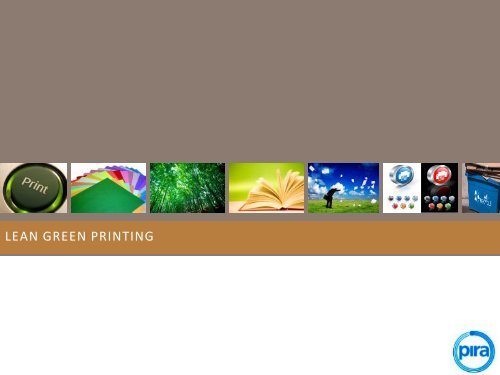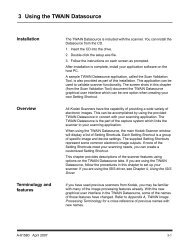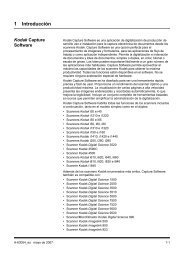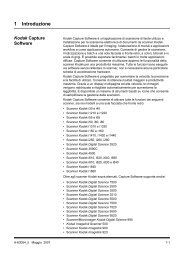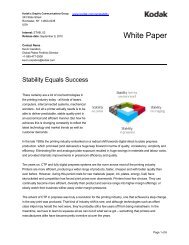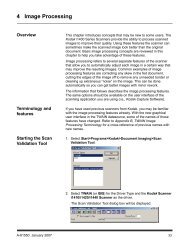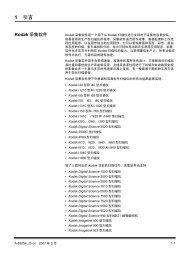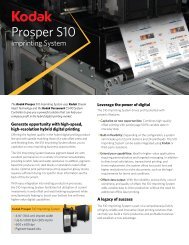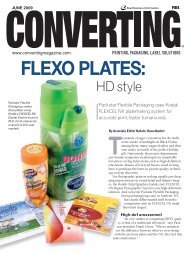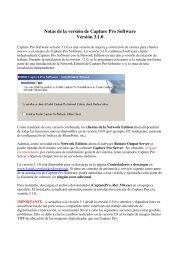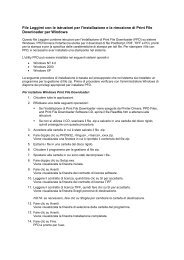LEAN GREEN PRINTING
LEAN GREEN PRINTING
LEAN GREEN PRINTING
Create successful ePaper yourself
Turn your PDF publications into a flip-book with our unique Google optimized e-Paper software.
<strong>LEAN</strong> <strong>GREEN</strong> <strong>PRINTING</strong>
INTRODUCTION
Introduction<br />
The environmental pressures on the print supply chain will continue and pressures increase, with<br />
print users keen to demonstrate their environmental credentials by using paper and board from<br />
independently verified sustainable sources and certified print suppliers.<br />
In future printers will develop some form of quantitative measurements to determine the carbon<br />
footprint of their activities, by job and by period.<br />
The various sections in this presentation can be briefly outlined as under:<br />
Market background: Definitions and key terms<br />
Environment friendly Printing<br />
The Paper Recycling Process<br />
Paper Chain Of Custody Schemes<br />
Printing Inks
MARKET BACKGROUND: DEFINITIONS & KEY TERMS
Market Background: Definitions & Key Terms<br />
Carbon Sequestration: The removal and storage of carbon from the<br />
atmosphere in carbon sinks (such as oceans, forests or soils) through physical<br />
or biological processes, such as photosynthesis.<br />
Chain of Custody (COC): schemes and certifications are third party audit and<br />
investigation processes examining each step of a product’s supply chain. These<br />
begin at the forest and are carried out by established forest certification<br />
programmes to ensure that products carrying their label include the type of<br />
fibre claimed and also meet their programme’s standards.<br />
CTP (Computer to Plate): A type of printing prepress process in which a digital<br />
image is transmitted directly from a computer to a plate used on a press. The<br />
CTP process eliminates the need for producing film (or negatives), as well as<br />
stripping and shooting plates. CTP technology serves to effectively reduce costs<br />
and increase productivity, with proponents of CTP also claiming that it offers<br />
better consistency and higher quality because of the elimination of the human<br />
error risk, since the file is transmitted digitally to the plate material.<br />
De-inking: the process of removing printing ink from waste paper in order to<br />
recycle waste paper. The process consists of passing pulped waste paper<br />
through a series of punched screens, slot screens, and centrifugal purifiers to<br />
mechanically separate all non-paper components such as staples and thick<br />
adhesive layers.
Market Background: Definitions & Key Terms<br />
Landfill: A large, outdoor site where solid waste is disposed off, usually by<br />
burying.<br />
MIS (Management Information System): a subset of the overall internal<br />
controls of a business covering the application of people, documents,<br />
technologies, and procedures by management accountants solve business<br />
problems such as costing for a product, service or a business-wide strategy.<br />
Management information systems are used to analyze other information<br />
systems applied in an organization’s operational activities, thereby being<br />
distinct from regular information systems .<br />
Polylactic Acid (PLA): a biodegradable, thermoplastic, aliphatic polyester<br />
derived from renewable resources, such as corn starch (in the U.S.) or<br />
sugarcanes (rest of world). Even though PLA has been known for more than a<br />
century, commercial interest in it has grown only recently because of its<br />
biodegradability.<br />
Recycling: the process by which materials are collected and used as raw<br />
materials for new products.<br />
VOC (Volatile Organic Compounds): compounds that have a high vapor<br />
pressure and low water solubility. Many VOCs are human-made chemicals that<br />
are used and produced in the manufacture of paints, pharmaceuticals, and<br />
refrigerants.
ENVIRONMENT FRIENDLY <strong>PRINTING</strong>
Environment friendly printing<br />
Printers and packaging manufacturers are taking steps to reduce their environmental impact in<br />
a systematic, formally accredited manner, adhering to standard methodology.<br />
Printing’s key environmental impact factors are given below:<br />
Paper Production<br />
‣Forestry<br />
‣Energy use<br />
‣Transportation<br />
‣Recycling and de-inking<br />
‣Water use<br />
Printing and finishing<br />
‣Process & production waste and redundancy<br />
‣Plastics<br />
‣VOC Reduction<br />
‣Ink and varnish usage
Environment friendly printing<br />
Printing & Finishing cont’d:<br />
‣Distribution<br />
‣Apparent over-packaging<br />
‣Energy and water use<br />
Product disposal<br />
‣Recycling<br />
‣Landfill<br />
‣Carbon sequestration.<br />
Core activities to be undertaken by Printers for maintaining an Environment-friendly focus:<br />
• Printers will have to source paper and board from certified, well-managed forest sources, or use<br />
post-consumer waste.<br />
• Paper and board will increasingly be post-consumer recycled, or will be from certified forestry<br />
sources, with chain of custody such as FSC, PEFC or SFI a minimum for the majority of printed<br />
products.
Environment friendly printing<br />
• Lesser set-up and running waste will be required, with printers ordering exact quantities and not<br />
accepting the current trade tolerances.<br />
• Printers will use more ‘lean’ manufacturing and administration processes with waste reduction a key<br />
component.<br />
• Companies will also operate a formal, accredited environmental management system developing<br />
from ISO 14001, with significant measures reported as accounts.<br />
• The carbon footprint measures will be applied and companies will work actively to reduce their<br />
impact. New technology will also be widely applied.<br />
• New management information systems (MIS) tools will eliminate internal waste and errors; they will<br />
continually monitor production inputs and outputs, recording the carbon footprint impact and<br />
providing early warnings that will highlight earlier management action.<br />
• Premises will employ more energy-efficient features throughout, to improve environmental<br />
performance and also to reduce costs.<br />
• Centralised compressors and pumps can offer savings over individual equipment on presses and<br />
equipment.<br />
• New lighting and heating systems will be used in factories and offices; waste heat from presses and<br />
driers will be utilised, and there will be sustainable energy generation such as solar panels and wind<br />
turbines installed along with generators to provide back-up power sources.
Environment friendly printing<br />
• Press manufacturers are now using more independent servo-controlled motors to drive their<br />
presses, and this will also reduce energy consumption.<br />
• Machines will contain sensors and links back to the supplier, who can then monitor and advise on<br />
preventative maintenance so as to ensure optimal performance.<br />
• Print companies are ordering consumables in returnable, re-usable containers. All packaging<br />
materials, including ink containers, will be recycled, with larger printers buying ink and coatings in<br />
high-volume refillable containers or refillable cartridge dispensers.<br />
• More plates are being exposed in CTP (Computer to Plate) systems with no chemistry or processing<br />
required.<br />
• On presses, better temperature and process control will reduce the need for alcohol in the fount.<br />
Press wash-up will be through closed automatic systems with all liquid waste collected and recycled.<br />
• Heatset and solvent ink users will use solvent recovery systems, with waste solvents used to heat<br />
afterburners and factories.<br />
• All solid, liquid and atmospheric emissions will be recorded and sent to suitable waste treatment<br />
handlers.<br />
• There will be significant strides made in bindery and finishing technology to minimise set-up and<br />
process waste, particularly for very short digital runs, where new techniques such as laser cutting and<br />
scoring will reduce the need for dies and tools.
Environment friendly printing<br />
• All waste will be segregated and re-used where practical and recycled with plates and packaging<br />
waste. Most companies will run formal waste reduction schemes as part of their lean agenda.<br />
• Formal environmental accreditation is useful for demonstrating to customers that businesses are<br />
taking concrete action rather than pretending to do so.<br />
• Systems such as ISO 14000, FSC, PEFC, SFI, PAS 2050 (carbon footprint), Acorn BS8555, Green<br />
Dragon, or the EMAS Eco-Management and Audit Scheme will be used.<br />
• These above systems will be developed into accredited carbon footprint methods and printers will<br />
provide the results on a project by project basis to customers and for company performances over a<br />
period.<br />
• Currently there are several embryonic carbon footprint calculators available but these provide very<br />
different results and have little scientific credibility. The Carbon Trust offers a broad outline at<br />
http://www.carbontrust.co.uk/solutions/CarbonFootprinting/FootprintCalculators.htm<br />
• Companies can log in and provide a variety of input to work out their impact, alongwith receiving<br />
advice and consultation on the steps necessary to minimise their environmental impact. These will<br />
develop into properly accredited tools well before 2018 and will become part of the MIS.<br />
• Advanced systems will calculate the relative impacts of multimedia campaigns, as the use of<br />
electronic systems – email and websites – have their own environmental impacts, with significant<br />
power use (US power consumption in the data server industry is at par with the energy consumption<br />
of the paper industry, although much of that energy is from burning waste biomass).
Environment friendly printing<br />
• There will be major issues over recycling or disposal of computers and servers. These tools will be<br />
used by the design department to build a specification to minimise the environmental impact, for<br />
example the use of varnish lamination, or the effect of a 115gsm stock against 130gsm, taking into<br />
account the cost of postage.<br />
• The choice of alternative materials and production methods will have different environmental<br />
impacts, and these will be provided with the estimate and will be a factor in determining where jobs<br />
are placed.<br />
• Packaging suppliers and retailers will face different kinds of pressure to minimise excessive<br />
packaging. Consumer pressure will lead to better package design and appropriate use of materials.<br />
• Outside the control of the printer, significant environmental benefits will be gained by buyers<br />
ordering appropriate quantities of product.<br />
• Book and magazine publishers will move away from sale or return models, with retailers providing<br />
better demand profiling and ordering smaller quantities.<br />
• This will reduce the quantities of unsold print products that go for re-pulping unread. For printers, it<br />
will be another driver to reduce print run length.
THE PAPER RECYCLING PROCESS
The Paper Recycling Process<br />
Recycled Paper – Definition & Attributes<br />
• There is no single definition for recycled paper. In the US the Environmental Protection Agency(EPA)<br />
defines it as 30% post-consumer waste, while WRAP (the Waste & Resources Action Programme)<br />
suggests that recycled paper should be 70% of recovered fibre.<br />
• The NAPM (UK National Association of Paper Makers) meanwhile quotes ‘The Sustainable Office<br />
Forum (TSOF)’ checklist, that states: recycled paper should include as high a proportion of postconsumer<br />
waste fibre as possible.<br />
• Recycling one tonne of newsprint saves about one tonne of wood, while a tonne of fine paper saves<br />
a little more than two tonnes of wood. Most of the wood used for paper and board (certainly in<br />
developed markets) comes from farmed tree sources with fast growing trees being replanted to<br />
replace the harvested ones.<br />
• The main benefit for recycling is to reduce the landfill burden. As paper decomposes, it releases<br />
methane which is a major contributor to greenhouse gas when not collected and burnt as fuel.<br />
• The EIA (Energy Information Administration, part of the US Department of Energy) claims a 40%<br />
reduction can be attributed to recycling, while the Bureau of International Recycling (BIR) claims a<br />
64% reduction.<br />
• Virgin pulp making burns waste bark and chemicals from the trees, while recycling uses energy from<br />
the national grid that often involves fossil fuels, as many recycling plants are located in urban areas.<br />
The US EPA has found that recycling causes 35% less water pollution and 74% less air pollution.
The Paper Recycling Process<br />
Key Steps in the Paper Recycling Process<br />
• Twine and strapping, etc, is removed from the stream by a ‘ragger’, metal straps and staples can be<br />
screened out or removed by a magnet<br />
• Repulping in water – applying mechanical action to separate fibres from each other<br />
• Screening – using screens with either slots or holes, to catch contaminants that are larger than pulp<br />
fibres<br />
• Centrifugal cleaning – spinning the pulp slurry causes materials that are denser than pulp fibres to<br />
move outward for removal<br />
• De-inking – passing air bubbles through the pulp with a surfactant that causes ink particles to collect<br />
with the foam on the surface. By removing contaminated foam,pulp is made brighter<br />
• Washing to remove small particles by passing water through the pulp<br />
• Bleaching, with peroxides or hydrosulphites, to remove colour from the pulp<br />
• Paper-making – the recovered fibre is made into new paper or board in the same way that virgin<br />
paper is made<br />
• Dissolved air flotation – Process water is cleaned for reuse
The Paper Recycling Process<br />
• Waste disposal of unusable material (mostly ink, plastics, staples, filler and short fibres) – sludge –<br />
may be incinerated to provide energy at the mill, used as a fertilizer or as a filler for building and road<br />
materials.<br />
An overview of the Paper Recycling Process<br />
• Recycling mills may have polluting by-products, such as sludge. De-inking at Cross Pointe’s Miami,<br />
Ohio, US, mill results in sludge weighing 22% of the weight of wastepaper recycled, although<br />
improved techniques reduce this byproduct.<br />
• In 2008, scientists developed a method of removing one of the most difficult contaminants, ink, with<br />
an enzymatic catalyst approach rather than with expensive and polluting chemicals.<br />
• There is debate about the use of radiation-cured inks and coatings, flexo printed newspapers and<br />
digital print, particularly inkjet, as there are issues with the de-inking processes.<br />
• As of September 2008, Hewlett-Packard, InfoPrint Solutions Company, Kodak and Océ have been<br />
developing a Digital Print De-Inking Alliance.<br />
• This above alliance will conduct research to assess digital print compatibility with de-inking and<br />
paper recycling processes worldwide, focusing on printer, paper and chemical additive solutions, and<br />
their various combinations, with the aim of promoting best practice in recycling standards across the<br />
industry. The Alliance has stated its commitment to seek co-operation from all relevant industries.
The Paper Recycling Process<br />
• While currently many recycling companies do have the capability to deal with digitally printed paper,<br />
the need for a worldwide industry standard is clear.<br />
• The industry would definitely benefit from research into different print technologies and the best<br />
recycling processes to use.<br />
• In conventional newspaper printing, drying is accomplished by absorption of the ink oils into the<br />
paper structure.<br />
• The oils in offset news inks never totally dry. In newspaper flexo, the water-based inks dry and form<br />
a hard film layer of acrylic polymer and pigment.<br />
• Flotation de-inking is not adequate to remove the cellulose fibre bond and dry ink film. However,<br />
flexo news has been successfully recycled using a combination of washing and flotation.<br />
• A typical problem with flexo news deinking is that secondary pulp yield is reduced and the<br />
brightness may be lower.<br />
• The problem with de-inking water-based ink on uncoated paper has drawn attention to publication<br />
printers in general, who are continuing to work towards the use of water-based ink in gravure<br />
publications.<br />
• De-inking of these products at the wide, and widening scale required will pose more of a challenge.
PAPER CHAIN OF CUSTODY SCHEMES
Paper Chain of Custody Schemes<br />
‣ The need for a more meaningful and consistent classification of the environmental impact of paper<br />
and board has led to the concept of independent assessment, with formal chain of custody schemes<br />
obtaining wide support from the industry, government and environmental groups.<br />
‣ The method favoured is an independent endorsement of the sourcing of paper, using a<br />
documented chain of custody from forest to pulpmill to papermill to merchant to printer/converter to<br />
retailer to consumer.<br />
‣ At each stage of the chain, the body is identified and records the source and destination of the<br />
product, using an identification mark on the output that is recorded by the next converter. This allows<br />
each product to guarantee to consumers that it comes from a well-managed source.<br />
‣ As with most aspects of the graphic arts there are choices to make: to which scheme should you<br />
become accredited. The most widely used schemes are PEFC, FSC and in North America, SFI.<br />
These schemes are explained below:<br />
PEFC (Programme for the Endorsement of Forest Certification schemes)<br />
• This is an independent, non-profit, non-governmental organisation, founded in 1999, that promotes<br />
sustainably managed forests through independent third-party certification.<br />
• The PEFC provides an assurance mechanism to purchasers of wood and paper products that they are<br />
promoting the sustainable management of forests.
Paper Chain of Custody Schemes<br />
• PEFC has in its membership 35 independent national forest certification systems, of which 25 to date<br />
have been through a rigorous assessment process, involving public consultation and the use of<br />
independent assessors to provide the assessments on which mutual recognition decisions are taken<br />
by the membership.<br />
• These 25 systems account for more than 200 million hectares of certified forests, producing millions<br />
of tonnes of certified timber to the marketplace, making PEFC the world’s largest certification system.<br />
• The other national members’ schemes are at various stages of development and are working<br />
towards mutual recognition under the PEFC processes.<br />
• PEFC-recognised forest certification denotes sustainable forest management and consumption of<br />
wood as a renewable, environmentally friendly raw material.<br />
• The stewardship and use of forests and forest land should be conducted in a way, and at a rate, that<br />
maintains their biodiversity, productivity, regeneration capacity, vitality and potential to fulfil, now<br />
and in the future, relevant ecological, economic and social functions, at local, national and global<br />
levels, and does not cause damage to other ecosystems.<br />
• The PEFC logo should have the code of the mill/merchant/printer/converter included, so allowing a<br />
trace to be made if necessary.<br />
• To achieve accreditation, the company must prove that it operates a robust system to ensure that<br />
there is no chance of mixing raw materials, and that all stock is accurately monitored.
Paper Chain of Custody Schemes<br />
The PEFC Logo<br />
The SFI Logo<br />
The FSC Logo<br />
Source: PEFC<br />
Source: SFI<br />
Source: FSC<br />
SFI – A PEFC-based scheme<br />
• The Sustainable Forestry Initiative(SFI) is a PEFC-based scheme operating in North America.<br />
• SFI Inc. is an independent, charitable organisation dedicated to promoting sustainable forest<br />
management, working with conservation groups, local communities, resource professionals,<br />
landowners, and other organisations and individuals.<br />
• The standard is used widely across North America, and has strong acceptance in the global<br />
marketplace, delivering a steady supply of third-party certified wood from well-managed forests.
Paper Chain of Custody Schemes<br />
SFI cont’d:<br />
• SFI forest certification promotes responsible forestry practices. To be certified, forest operations<br />
across the US and Canada must be audited against the SFI forest standard.<br />
• SFI chain of custody certification extends into the marketplace by tracking fibre content from<br />
certified lands through production and manufacturing to the end product.<br />
• SFI fibre sourcing requirements address the reality of global fibre markets and the fact that only 10%<br />
of the world’s forests are certified.<br />
• Programme participants must ensure the raw material in their supply chain comes from legal and<br />
responsible sources, whether the forests are certified or not.<br />
• In 2005, the SFI programme was endorsed by PEFC after a detailed examination by a PEFC-approved<br />
assessor – from its development to its forestry content, chain of custody certification and<br />
accreditation policies. This endorsement adds international value to SFI’s position as a highly<br />
respected, third-party certification program in North America.<br />
FSC – Forestry Stewardship Council<br />
• The Forestry Stewardship Council is an independent, non-governmental, non-profit organisation<br />
established to promote the responsible management of the world’s forests.<br />
• The FSC provides standard setting, trademark assurance and accreditation services for companies<br />
and organisations keen on responsible forestry.
Paper Chain of Custody Schemes<br />
• All FSC-certified forests must comply with the FSC’s rules about how the forests should and should<br />
not be managed.<br />
• When a forester decides to become FSC-certified, he or she will make changes to comply with the<br />
relevant FSC requirements. Thus, the FSC has a direct and permanent positive impact on the world’s<br />
forests and the people living from, in and around the forest.<br />
• The FSC principles and criteria describe how the forests have to be managed to meet the social,<br />
economic, ecological, cultural and spiritual needs of present and future generations. They include<br />
managerial aspects as well as environmental and social requirements.<br />
Summary of FSC’s functions:<br />
‣Prohibit conversion of forests or any other natural habitat<br />
‣Respect of international workers rights<br />
‣Prohibition of use of hazardous chemicals<br />
‣Respect of human rights with particular attention to indigenous peoples<br />
‣No corruption – following of all applicable laws<br />
‣Identification and appropriate management of areas that need special protection (e.g.cultural or<br />
sacred sites, habitat of endangered animals or plants)
Paper Chain of Custody Schemes<br />
The 10 FSC Principles<br />
‣Principle 1: Compliance with all applicable laws and international treaties<br />
‣Principle 2: Demonstrated and uncontested, clearly defined, long-term land tenure & use rights<br />
‣Principle 3: Recognition and respect of indigenous peoples’ rights<br />
‣Principle 4: Maintenance or enhancement of long-term social and economic well-being of forest<br />
workers and local communities and respect of worker’s rights in compliance with ILO conventions<br />
‣Principle 5: Equitable use and sharing of benefits derived from the forest<br />
‣Principle 6: Reduction of environmental impact of logging activities and maintenance of the<br />
ecological functions and integrity of the forest<br />
‣Principle 7:Appropriate and continuously updated management plan<br />
‣Principle 8: Appropriate monitoring and assessment activities to assess the condition of the forest,<br />
management activities and their social and environmental impacts<br />
‣Principle 9: Maintenance of high-conservation value forests (HCVFs), defined as environmental and<br />
social values that are considered to be of outstanding significance or critical importance<br />
‣Principle 10: In addition to compliance with all of the above, plantations must contribute to reduce<br />
the pressures on and promote the restoration and conservation of natural forests.
<strong>PRINTING</strong> INKS
Printing Inks<br />
• Conventional offset printing inks can contain petroleum distillate, vegetable oil or a mixture of the<br />
two.<br />
• The choice of options and their effect on the environment raises a number of pertinent issues<br />
involving the use of raw materials from renewable resources, freedom from volatile organic<br />
compound (VOC) emissions, reduced hazards to human health and whether the printed waste is<br />
recyclable.<br />
Table: Characteristics of oils in sheet-fed offset printing inks<br />
Categories Petroleum Distillate Vegetable Oil<br />
Source<br />
Hydrocarbons from coal<br />
and crude oil<br />
Mixed fatty acid glycerides from plants<br />
and trees<br />
Typical Examples<br />
Distillate with boiling<br />
range 260–290°C<br />
Linseed, soya, tall, rapeseed, tung,<br />
coconut and castor oils<br />
Health & Safety Non-hazardous Non-hazardous<br />
Environmentally Sustainable<br />
Resource<br />
Classified as VOC in Ink &<br />
Drying<br />
No<br />
No<br />
Yes<br />
No
Printing Inks<br />
Table: Characteristics of oils in sheet-fed offset printing inks cont’d:<br />
Categories Petroleum Distillate Vegetable Oil<br />
Print Recyclable Yes Yes, but can be more difficult with aged<br />
prints<br />
Ink Setting Speed Excellent Good<br />
Hardness of drying Good Good<br />
Source: Pira International Ltd<br />
Sustainability and Green Alternatives for the future<br />
• Sustainable and green options will be more in demand in the next 10 years. Social responsibility<br />
calls for replacing harmful inks with biodegradable ones.<br />
• Inkmakers are exploring alternative raw material sources to oil, the so-called green polymers.<br />
There has been much work to replace mineral oil with sustainable sources.<br />
• For example, soybased oils are popular in North America, while vegetable-based inks are growing<br />
in importance. Other materials can also be sourced from sustainable resources.
Printing Inks<br />
• In some regions, the use of vegetable oils to replace petroleum distillates is being actively promoted<br />
both through legislation and by aggressive lobbying from interested parties citing environmental,<br />
technical and safety reasons.<br />
• In other countries, however, vegetable oils are still viewed less positively, leading to some debate on<br />
their relative merits and concerns about potential deforestation as a by-product of growing crops for<br />
oil and bio-diesel. Fluctuations in oil prices will also change the economic benefits.<br />
• Sheet-fed inks containing petroleum distillates, vegetable oils or a mixture have been available for<br />
decades.<br />
• Petroleum distillates are used to give fast ink setting and nonset- off properties, while vegetable oils,<br />
primarily linseed and tung oil, are included for their oxidation drying properties.<br />
• More products will be formulated using sustainable resource raw materials, thus providing an<br />
environmentally friendly option for the printer when using these products in conjunction with lowalcohol<br />
founts and low-VOC washes. Sun Chemical,for example, has launched what it claims to be the<br />
first UV sheet-fed inks that use 30% sustainable material - Suncure Advantage.<br />
• Other renewable raw materials are also being examined and will become commonly used products<br />
in course of time. Sugars from wood hydrolysates and corn starch can be fermented to lactic acid, and<br />
when polymerised it produces plastics like urethanes, polyesters and polyols, that can be used for ink.<br />
• Polylactic acid (PLA) is already being used for the preparation of emulsion polymers and green<br />
polymers for biodegradable ink.
Printing Inks<br />
• Biodegradable pigments may be derived from plant sources or marine algae. They are already<br />
known, but they do not perform favourably compared to well-established organic synthetic pigments.<br />
• Biodegradable liquid inks will come from water-based chemistry or formulated with green solvents<br />
such as ethanol, 1,3-propanediol, and esters based on biomass derivatives.<br />
Environmental, Health & Safety Concerns<br />
• Environmental and health & safety concerns are increasing weighing on manufacturers. Ink industry<br />
bodies help to reduce and outlaw potentially harmful materials, promoting alternatives to volatile<br />
organic compounds for the benefit of the planet as well as the pressroom.<br />
• The European Registration, Evaluation, Authorisation and Restriction of Chemical substances<br />
(REACH) legislation on chemicals is a major challenge for European ink makers. The intention is to<br />
provide a safer, healthier world and it will involve every chemical marketed in an EU country being<br />
registered for intended use.<br />
• The use of difficult-to-recycle materials will be largely eliminated, with UV varnish and OPP<br />
laminates used sparingly with water-based coatings more prevalent along with biodegradable<br />
laminates.<br />
• Flexo and gravure will largely eliminate the use of aromatic solvents, especially in developed<br />
markets.<br />
• Inkjet inks will also be dominated by UV and aqueous formulations, with eco solvent grades<br />
replacing more aggressive solvent-based inks and with MEK and acetone largely eliminated.
Printing Inks<br />
Packaging & the Environment<br />
• Packaging is an integral and essential part of the industrial and commercial supply chain.<br />
• It protects goods from damage, allows efficient transport distribution, offers convenience, prolongs<br />
shelf-life, enables easy use, informs the consumer and helps to promote goods in a competitive<br />
marketplace.<br />
• As well as protecting and preserving goods, packaging carries vital information about ingredients,<br />
keeps hazardous products away from children, and ensures goods are safe (where packaging cannot<br />
be opened without showing evidence of tampering).<br />
• The popularly presented image of packaging often fails to recognise the contribution that it makes to<br />
modern lifestyle and exaggerates its environmental impact.<br />
• Attention is usually focused on the waste generated by used sales packaging .This ignores the fact<br />
that packaging protects far more resources than it uses and that it reduces overall waste.<br />
• INCPEN(The Industry Council for Packaging and the Environment)has carried out a lot of research,<br />
including commissioning studies, on a wide range of social and environmental aspects of packaging. It<br />
promotes not the removal, but the use of lower impact packaging.
About Pira International<br />
• Leading international strategy and technical consultants<br />
• Track record in delivering value to clients for over 75 years<br />
• 170 staff-including global network of consultants and researchers<br />
• Off-the-shelf market reports, multi-clients, special interest groups and<br />
consultancy<br />
• For more information please contact:<br />
Stephen Hill on +44 (0) 1372 802 025<br />
(stephen.hill@pira-international.com)


